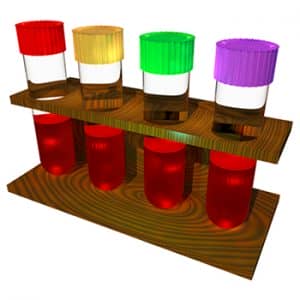 Looking for the best order of the draw acronym?
Looking for the best order of the draw acronym?
This page will give you a few incredible options.
But there’s also a better way to master phlebotomy. It’s easier and faster than using acronyms.
Even better:
The mnemonic strategy I’m about to share will save you time because it gives you a memory tool you can use for everything else you have to learn.
I’m talking about rapidly remembering everything from patient names to new guidelines you need to follow.
You’ll be able to memorize it all in a flash, like all of my other students in medicine and nursing.
Ready to master the order of the draw and set the stage for learning faster and retaining medical knowledge much longer than acronyms on their own allow?
Get your draw tubes ready and let’s dive in.
How to Remember the Order of Draw Quickly (And Forever)
The problem with most mnemonics for the blood draw order is that they’re tragically boring.
That’s right.
There’s nothing interesting, unusual or memorable about them. Worse, the people sharing these mnemonic examples usually make them unusually difficult. They present an additional challenge to remember instead of simply ushering the information into long-term memory.
In case you haven’t seen one of these acronyms before, this is what websites and books covering mnemonics for the order of the draw usually suggest:
- Boys for blood culture (variable)
- Love for light blue
- Ravishing for red
- Gargoyles for gold
- Like for light green
- Deans for dark green
- Love for lavender
- Greek for gray
- Yogurt for yellow
What could be more boring and difficult to remember than a long phrase like “boys love ravishing gargoyles for gold like deans” etc.?
Literally, the only interesting part of this bizarre acronym is the idea of gray yogurt that barely shines through. Otherwise, all this acronym presents is a lot of chaos.
We can do better and here is how.
The Most Exciting Mnemonic For Order Of The Draw
Instead of vague and generic associations, your mind remembers better when everything is concrete, specific and located in context – ideally a spatial context. That way you can think back to where you were imagining the association between the letter in the acronym and recall the target word better.
That’s why I suggest the following when you start memorizing the order of the draw:
Start by imagining nine spots you’re familiar with and remember relatively well.
Why? Because I’m about to teach you an ancient and science-backed approach to learning called the Memory Palace technique. By drawing upon both your spatial and visual memory, this unique learning technique uses familiar locations like your home, workplace or even art galleries and libraries.
Wherever you choose, the next step is to divide your chosen location for the steps of the draw into nine distinct spots. For example, one of my favorite ways to use the Memory Palace technique for step-by-step learning tasks is to divide up a familiar cityscape:
I like this kind of layout for helping my students learn the order of the draw because skyscrapers look a lot like syringes.
Once you’ve created your first Memory Palace, you officially have assigned a highly memorable spot for all nine pieces of information involved in this learning task.
What To Do Instead Of Using An Uninteresting Acronym
Instead of telling a story based on uninteresting words that make no sense, we’re going to create a rich and immersive experience.
For example, instead of “boys” (whoever they are) for “blood culture,” we’re going to use a reference that is specific and unique.
Culture Club comes to my mind because the singer of this group is called Boy George. I imagine him drawing a variety of blood cultures. To do that, I place one of their album covers on station one of this Memory Palace (the first building):
Can you see how using specific mnemonic images is much more direct and presents a much stronger way to remember things? Even if you don’t use Boy George, the principle is the same:
Use highly specific associations and the individual pieces of information related to the draw will pop back into your memory with greater ease.
To make sure the association lasts, all you have to do is complete the list using the Memory Palace and then add a bit of spaced repetition.
Next, instead of “love” for “light blue,” which has zero connection to the color blue, I will use a Smurf.
Why?
Because Smurfs are light blue by definition. This fact makes a natural link that instantly makes the needed fact about the blood drawing process easy to remember.
To make the image strange and interesting, I will have him blowing a blue syringe from a trumpet.
This is the kind of mental imagery that makes information easy and fun to recall.
Now, if I continue giving you my examples, I will rob you of the ability to learn this skill quickly on your own.
The trick is to think alphabetically and imagistically. Learning the pegword method will help you do this quickly.
Linking: The Ultimate Order of Draw Cheat Sheet For The Mind
Another strategy you can use is the linking and story method.
In the previous example, I used a subtle version of this by having the light blue Smurf shoot a syringe from a trumpet.
But we could have it shoot something red so that we remember this is the next color in the sequence.
Using this approach, the story goes that Boy George from the Culture Club has hired a light blue Smurf who shoots red radishes from his trumpet. These completely cover the third building in your row.
Since gold is the next color, you just need to come up with an interesting association. For example, you could have King Midas getting greedy for some of those radishes to also hit his building made of gold.
Then you just keep the story going, linking each association to the nine spots you’ve identified.
It’s a lot more interesting than trying to memorize a vague set of words tied to the letters “blrgldlgy,” isn’t it?
Master Phlebotomy Quickly
As you’ve seen, it can be fun and easy to remember the order of the draw.
If you need more help, or even just a bit of inspiration, my memory and learning student Rose Szwed was on my podcast. She shares how she used the Memory Palace technique for the order of the draw specifically and other aspects of phlebotomy.
Rest assured, memorization strategies like this are useful for medical terminology, anatomy and the names of your patients. It’s really just a matter of setting yourself up with the mnemonic tools. Sure, it takes a few hours to get prepared, but that’s a small price to pay in return to using them for the rest of your life.
If you’d like more help, please register now for my FREE Memory Improvement Kit:
It will walk you step-by-step through a few more variations on this technique that will take your learning speed to the next level.
In the meantime, I hope you’ve enjoyed discovering this simple, fun and much more engaging way to learn critically important information.
And thanks for being the kind of top-notch medical professional who cares enough to pursue mastery.
My compliments to you for that!
Related Posts
- How To Remember The Amino Acids: A Proven Mnemonic
If you need to know how to remember the amino acids, this detailed tutorial is…
- 5 Mnemonic Strategies You Can Use to Remember Anything
These 5 mnemonic strategies will help you use every mnemonic device with ease and efficiency.…
- Cranial Nerves Mnemonic: Remember All 12 Cranial Nerve Names in Order
A good cranial nerves mnemonic can be hard to find. Here are 12 you can…










